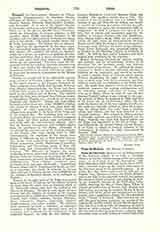

Tiraspol (or CHERSONESE), Diocese of (TIRASPOLENSIS; CHERSONENSIS), in Southern Russia, suffragan of Mohilev, covers the governments of Saratov, Samara, Kherson, Ekaterinoslav, Taurida, and Bessarabia. It is one of the largest dioceses in the world, and has an area of 462,504 square miles. There are in the diocese 350,000 Latin Christians, chiefly the descendants of German colonists, in 100 parishes, about 40,000 Armenian Catholics in 50 parishes, and over 300 Chaldean Catholics for whom there is one parish. The priests number about 210, 60 being Armenians. The bishop lives at Saratov, the capital of the government of the same name. The ecclesiastical institutions are, besides the cathedral chapter, the seminary for priests at Saratov, which has a rector, an inspector, a spiritual director, and five professors; there is also a seminary for boys at the same place, with three professors. Religious orders are not permitted. For some years the Armenian Catholics have had an Apostolic administrator of their own (Sarkis Ter Abrahamian) to whom all Armenian Catholics in the whole of Russia are subject. In important decisions he is dependent on the Bishop of Tiraspol.
During the second half of the eighteenth century large numbers of German colonists went to Russia at the urgent request of the Empress Catherine II. These emigrants were chiefly from Bavaria, Würtemberg, Saxony, Alsace-Lorraine, the Tyrol, and Switzerland; they settled in the fruitful but uninhabited lands in the southern part of Russia. The colonies founded by them have retained their German names, as Mannheim, Munich, etc., as well as the German language and character. Among the half-million German settlers there were about 180,000 Catholics, who settled in villages of their own, apart from the members of other confessions. These Catholic villages were generally in the basin of the Volga and of the Caspian Sea. The Catholics were cared for spiritually at first by a few priests who had emigrated with them, but these pastors soon succumbed to privations and the unaccustomed climate. After this the Russian Government sent Catholic priests from the provinces on the Baltic. Alexander I transferred the pastoral care of the Catholic colonies to the Jesuits, who came among them in 1803. Unfortunately, the expulsion of the Jesuits from Russia in 1820 put an end to their fruitful labors. The Jesuits were replaced by priests from various Polish monasteries, chiefly Dominicans, Carmelites, Trinitarians, and Vincentians, many of them old, feeble men, and unacquainted with the German language. The difference in tongues, the racial antipathy between priests and settlers, and the great distance from the residence of the bishop (St. Petersburg) enormously increased the difficulties of spiritual administration. Thus religious conditions grew gradually more and more intolerable. Negotiations between Rome and St. Petersburg led finally, in 1847, to a concordat, by which, in addition to several other dioceses, a German diocese was established for the colonists of Southern Russia, to be suffragan to Mohilev.
Saratov on the right bank of the Volga was settled upon as the see of the bishop, but the diocese received its name from the small town of Tiraspol, which in the fourteenth century had been the capital of the Diocese of Kherson. Besides its vast extent, the new diocese was also singular on account of the varying nationalities of its inhabitants, who included German, French, and Italian colonists, besides Russians, Poles, Armenians, Kirghiz, Circassians, Ossetes, Daghestanians, and other peoples. The Government promised to build a cathedral, an episcopal residence, a building for the episcopal curia, and a seminary, and to provide for the endowment of the cathedral chapter. In 1850 the first bishop, the German Dominican Ferdinand Helanus Kahn, was installed. The auxiliary bishop was a Pole. The promises of the Government were not fulfilled. On account of age and ill-health the bishop was unable to correct the existing grievances, nor was he sufficiently energetic to make the Government fulfil its obligations. In 1857 a seminary was opened, it is true, but in rented and inadequate quarters; the number of German teachers was also insufficient. After Bishop Kahn’s death (1864) the see remained vacant for eight years, all communication between Russia and the Holy See being at that time suspended. It was not until 1872 that the rector of the seminary, Franz Xaver Zottmann, was appointed bishop (b. at Ornbau in the Bavarian Diocese of Eichstätt in 1826). In 1864 he had visited Eichstätt and there secured some professors for the seminary.
Bishop Zottmann labored by speech, writing, and example, and by extraordinary activity in all directions, for the spiritual, moral, and material improvement of his diocese. He collected the money necessary to build a suitable cathedral, obtained a building for the seminaries, and spared no sacrifice to train a capable body of German parish priests. Without abandoning the rights of the Church, he kept on good terms with the Government, and thus could do much that was forbidden to the Polish bishops. He could issue pastoral letters in the diocese, undertake journeys for making confirmations and for visitation, arrange collections of money, and even go to Rome, where, in 1882, he was the first Russian Catholic bishop to pay homage to the pope. On account of illness he resigned in 1888, and died in his native city on December 12, 1901. He had made his diocese one of the best organized in Russia. His work was worthily carried on, after his resignation, by Anton Zerr, who came from a German colony near Odessa, and had been educated at the Tiraspol seminary. Zerr resigned in 1902 on account of ill-health, and was succeeded by Eduard von der Ropp. Scarcely two years had elapsed before von der Ropp was transferred to the See of Vilna. He was followed by the present bishop, Joseph Kessler, b. at Louis, a village of German colonists in the Government of Samara, in 1862; consecrated October 28, 1904.
JOSEPH LINS

